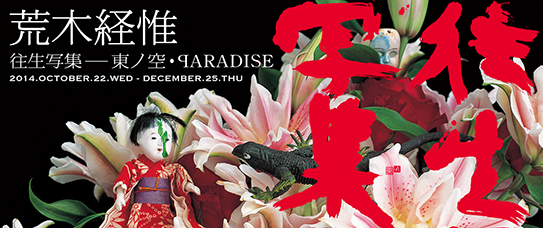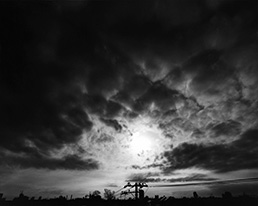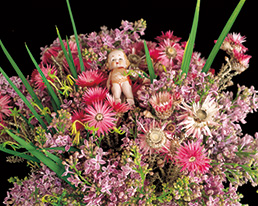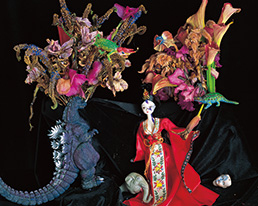The Shiseido Gallery is pleased to announce that it will host the exhibition Nobuyoshi Araki Ōjō Shashū : Photography for the Afterlife — EasternSky, PARADISE to run October 22 through December 25, 2014.
Photographer and contemporary artist Nobuyoshi Araki (“Ararchy” to his many fans) has been turning his camera lens to a truly wide variety of subjects since the 1960s, producing work that is often provocative and attention-getting. In 1964, he received the first Taiyō Award for Satchin, a collection of photographs of children in Tokyo's “low city” districts. In 1971, in Sentimental Journey, he chronicled his honeymoon travels with his new bride, Yōko, an effort that pioneered the diary-like “personal photography” genre that has become his distinctive stylistic approaches. He has remained extraordinarily prolific ever since.
The Japanese exhibition title, Ōjō Shashū (Photography for the Afterlife), is one Araki created based on the title of an influential Heian-era religious text, Ōjō Yōshū (Teachings Essential for Salvation), written in 985 by the Buddhist monk Genshin. Having culled what he considered essential from the various Buddhist sutras, treatises, and other sources, Genshin explained that the most important element in attaining salvation and rebirth in paradise after death was to pray fervently through repeated invocations of one's faith in Amida Buddha. This teaching would eventually become an important foundation of Pure Land Buddhism, one of Japan's most influential Buddhist sects.
Araki's Ōjō Shashū exhibition is a joint presentation taking place at three different venues in turn—the Toyota Municipal Museum of Art (4/22 – 6/29), the Niigata City Art Museum (8/9 – 10/5), and the Shiseido Gallery. Each of these exhibition features its own subtitle and a different selection of photographs. Having experienced a battle with prostate cancer surgery in 2009, followed by the passing of his beloved cat, Chiro, and the devastating Great East Japan Earthquake, Araki has come to embrace the idea that “death = passing,” and he makes this the focus of this three-part exhibition.
At the last of the three venues, the Shiseido Gallery will show the photographer moving from “death = passing” to “rebirth,” a reflection of his current frame of mind. The works comprising Eastern Sky offer a requiem to those who perished in the Great East Japan Earthquake, a series of photos Araki took each morning from the roof of his home while offering prayers for the recovery of the affected areas. The life force that quietly builds, marking each new day, makes the Eastern sky a powerful symbol of rebirth and resurrection.
The photographs in PARADISE at first seem to be of flowers blossoming colorfully in the darkness, but a closer look reveals nearly wilting petals and arrangements of dolls that instead tell stories of life and death. Araki says, “ Flowers are at their most sensual just before they die,” and here he makes these fading flowers a metaphor for human life, and for the preciousness and dearness that arise from life's very ephemerality. The exhibition will also include a new “GINZA” series taken this past summer.
Having become more conscious of “mortality,” and beginning to prepare for his own passing, Araki has been traveling through Toyota and Niigata, looking back and reflecting upon his own life, and now comes to the Shiseido Gallery ready to take off on a new journey toward “rebirth.” The Shiseido Gallery welcomes all to come appreciate this latest direction by Nobuyoshi Araki.



